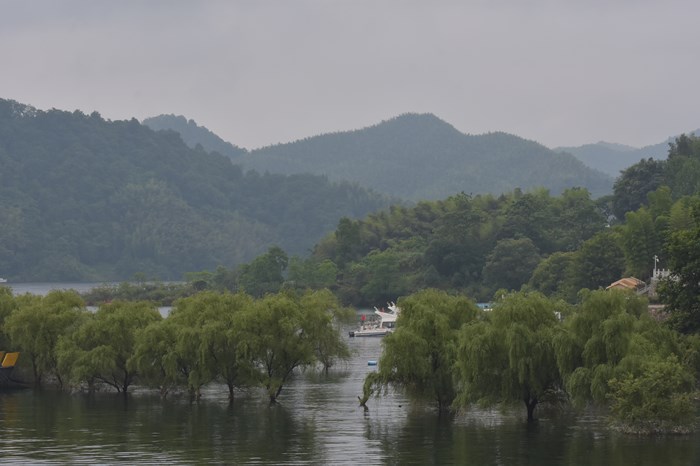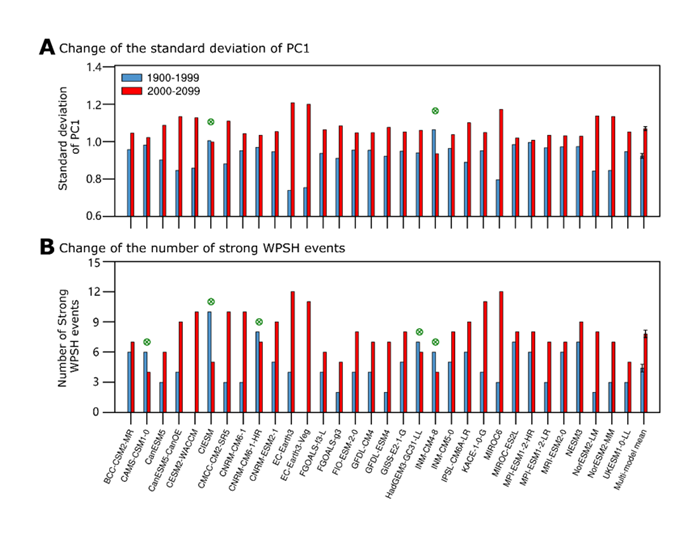

Image from the Proceedings of the National Academy of Sciences (PNAS)
It is understood that the conventional development shared socioeconomic pathway (SSP5) is a high forcing scenario and the only SSP scenario that can make the radiative forcing reach 8.5W/m^2 (watts per square meter) in 2100. The SSP585 scenario is a representative concentration pathway 8.5 scenario upgraded from SSP5. Radiative forcing refers to the net radiative change in the vertical direction of the tropopause caused by internal changes in the climate system, such as changes in carbon dioxide concentration or solar radiation, in the vertical direction of the tropopause, and is measured in watts per square meter.The Western Pacific Subtropical High (West Pacific Subtropical High) is the main component of the East Asian summer monsoon system and has an important impact on the East Asian summer climate. The Western Pacific Subtropical High has significant interannual variability. When it is abnormally strong, the southerly wind on the west side of the system carries a large amount of water vapor from the tropical ocean and meets the dry and cold air from the north, resulting in more precipitation in the middle and lower reaches of the Yangtze River in summer. Even severe floods occurred. In the summer of 2020, the unusually strong West Pacific subtropical high caused floods in the middle and lower reaches of the Yangtze River, causing losses to people's lives and properties.

Floods in the Yangtze River Basin in 2020, picture from Institute of Atmospheric Sciences, Chinese Academy of Sciences
The interannual variability of the WPSH is influenced by tropical SST. Through statistical analysis, the study points out that the tropical central Pacific SST and the Indian Ocean SST are the key factors affecting the main mode of the interannual variability of the Western Pacific Subtropical High. Tropical SST anomalies can cause circulation anomalies in the Northwest Pacific by regulating local and non-local precipitation and atmospheric convection. Using 32 CMIP6 models, the study found that 94% of the model simulation results indicated that the variability of the first mode of the Western Pacific subtropical high would increase in the context of global warming (see figure). CMIP6 is the sixth international coupling model comparison program initiated by the World Climate Research Program (WCRP). .
(A) Variation characteristics of the main mode variability of the WPSH in the 20th century (blue) and 21st century (red) in the 32 CMIP6 models, and all 30 models showed increased variability; (B) is the same as (A) , but it is the change of the strong western Pacific subtropical high event; most models show that the western Pacific subtropical high variability and the occurrence probability of the strong western Pacific subtropical high event will increase in the context of global warming. Image from Institute of Atmospheric Sciences, Chinese Academy of Sciences
Global warming will lead to an enhanced response of precipitation and atmospheric convection to changes in sea temperature, because according to the Clausius water vapor equation, the atmospheric saturated water vapor pressure increases exponentially with the increase of temperature, making the atmosphere under the background of climate warming. The water vapour content of the water vapour increases, and the water vapour response to temperature also increases with increasing temperature. The researchers believe that these changes, combined with the uneven warming of the background field SST, can lead to an enhanced response of atmospheric convection to SST in the central Pacific and a stronger circulation anomaly, which in turn increases the variability of the Western Pacific Subtropical High.The aforementioned studies suggest that the increased variability of the Western Pacific Subtropical High in the future can increase the probability of a strong Western Pacific Subtropical High event, indicating that global warming may make such a strong Western Pacific Subtropical High event in 2020, as well as related flood disasters in eastern my country. The probability of occurrence increases. The study further illustrates the importance of reducing emissions and carbon neutrality.
Whoa loads of very good material! casino en ligne Whoa all kinds of excellent knowledge! casino en ligne You revealed it wonderfully! casino en ligne Regards! An abundance of forum posts. casino en ligne Nicely put. With thanks. casino en ligne Lovely data. Appreciate it! casino en ligne You said it perfectly.! casino en ligne Nicely put, Cheers. casino en ligne Nicely put. Thanks! casino en ligne You said it very well.! casino en ligne